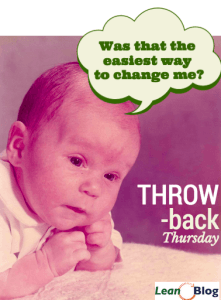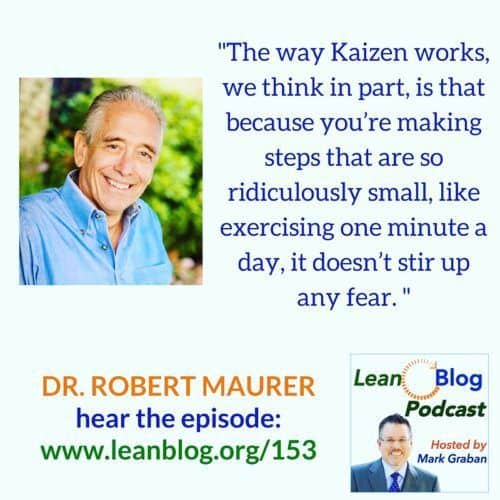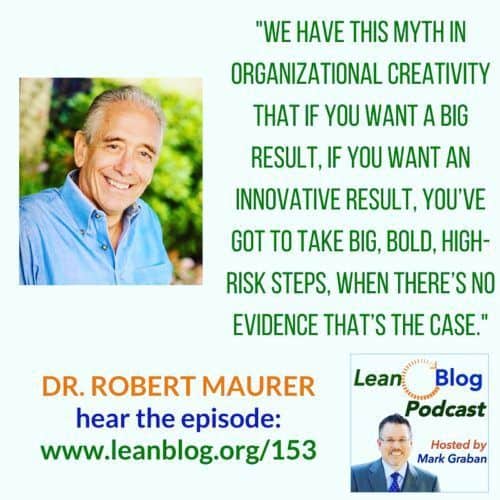
Back in 2012, I did a podcast interview (Episode 153) with a psychologist and family therapist, Robert Maurer, PhD.
It's been almost five years since the discussion, but I'm often reminded of what I learned from his books and his advice about small change.
It's human nature for us to be afraid of change. Instead of lecturing people to be brave, we need to work within our limitations.
How do we avoid the “fight or flight” instinct and reaction from kicking in?
We start by making change SMALL. That's a key Kaizen insight that Dr. Maurer is able to tie to the way our brain works.
Here's our original discussion:
I like this episode so much, I created a PDF summary as I've been doing for recent podcast episodes. Some of you like to read, so these are helpful. Some of you prefer to listen, which why I've been doing the “Lean Blog Audio” podcast series for some of my blog posts.
You can download the PDF or read the summary below in this post.
- Low-res PDF (for reading on screen)
- High-res PDF (for printing)
I've also re-released this as episode #279 (and I'll occasionally do this with older episodes that newer listeners might not know of).
And here's the text of the summary:
Kaizen and the Human Brain
In episode 153 of the Lean Blog Podcast, I had the pleasure of speaking to Robert Maurer, PhD who is the Director of Behavioral Sciences for the Family Practice Residency Program at Santa Monica UCLA Medical Center and a faculty member with the UCLA School of Medicine. Dr. Maurer is also the author of several books including One Small Step Can Change Your Life: The Kaizen Way. One Small Step Can Change Your Life was one of the topics of our conversation. His was one of the books I came across in my research for my book Healthcare Kaizen: Engaging Front-Line Staff in Sustainable Continuous Improvements, which I co-authored with Joe Swartz. Robert's book discusses applying a Kaizen, continuous small change, approach in the realm of therapy. He writes about the brain chemistry that causes people to fear change. He also later wrote another excellent book, The Spirit of Kaizen.
We started our conversation speaking about Robert's professional background. Robert is a clinical physiologist who works in a medical clinic where physicians just finishing medical school are trained for another three years to become family doctors. Robert explained he spends about half his time in the examination room with the residents giving them feedback on their communication skills, in addition to teaching them how to be more effective in their communication.
It was Robert's unique work setting that lead his research about Kaizen. As Robert explained, most therapists working in a typical office or clinic see people who have waited for enough pain to accumulate in their life and for excuses to run out, only to seek help when the problem is already severe. In a medical exam room, however, Robert has the unique opportunity to see patients long before issues arise. But, while the unique opportunity was there, no tools to help predict health in people who were there for brief visits were available to Robert, so he began collecting studies from around the world on long-term success. Robert found about two dozen studies that followed people anywhere from 15 years to 70 years to see what predicts success in all three areas of life: health, relationships, and work.
“And so, one day, I was reading the newspaper and there was a full-page ad for the Toyota brand of Lexus. For the umpteenth year they had won the JD Power customer satisfaction award and the thought went through my mind that maybe, there's something about building a high-quality car consistently year after year that metaphorically I might be able to apply to human behavior. And so, I started to look at the history of Toyota and Lexus,” Robert said.
“So that was how I got introduced to Kaizen, was through trying to see metaphorically if there was something about a quality car I could apply to a quality life.”
What Robert found was that small Kaizen changes can be used to develop habits that improve people's health and wellbeing in big and important ways.
”We found that if you could get people to exercise one minute a day, every single day, all of a sudden, we took away all their excuses. If I ask you to exercise an hour a day you've got all kinds of good reasons why you don't have time to do that. But if I ask you to exercise in place, while you're watching TV, one minute a day, then all of a sudden you're developing a habit.”
Robert explained that while starting one minute a day is small, it doesn't take large changes to have an impact on the body, and exercise in just three minute chunks throughout the day, adding up to a total of 30 minutes a day has been proven to have the same impact as 30 minutes at once per day.
“In our 70mm Dolby, super-sized, extreme makeover culture, it's just hard to believe these small steps can have such a profound influence on the body,” he said. “And what you're counting on is if you do something one minute a day at first of course it's annoying, then it becomes tolerable, and then you develop a habit.”
Around relationships, Robert pointed to research by Dr. John Gottman, who is a psychologist previously with the University of Washington, and now at The Gottman Institute. Robert said that what makes his work so extraordinary is that after studying about 10,000 couples over the last two decades, he can now interview fiancés for 15-minutes or less and predict the likelihood that couple will be happily married four years later vs. miserable and divorced; with 93 per cent accuracy.
“If I can summarize his research for you, it boils down to two things: One was how couples deal with conflict, which is not surprising, but some of what he found was common sense, some of it was quite uncommon. The second thing he found was positive attention outweighed negative on a daily basis by five to one when the relationship wasn't going well, 20 to one on the days when it was.”
Robert explained this positive attention didn't have to be big events like candlelight dinners and trips to the theatre, but rather just small trivial moments like putting down the remote control, the newspaper, or the telephone, when a spouse walks through the door, or remembering to ask them about their trip to the dentist.
“Those small, trivial moments accumulate throughout the day are more predicative of success than anything else a couple could do. So, it's probably the best example of Kaizen in a relationship I can think of,” Robert said, but added that small, internal changes can also make an impact. “People who are in counselling for example, are usually their going around during the day rehearsing all the arguments they had last night or the ones they anticipate today. We ask them to go through the day thinking of one or two positive things about their mate and we have evidence it changes your brain chemistry and it certainly changes how you walk through the door that night.”
This chemistry and makeup of the brain has a lot to do with how Kaizen works, as Robert explained.
At the base of the mid-brain, where the emotions and the survival mechanism in the brain lives, is the amygdala, which is about the size of an almond. He continued to describe the amygdala as where something called the “fight or flight” response lives.
“It's basically the fear mechanism in the body, so that when you stepped out of your cave in the morning, with a body that didn't see well or smell well, couldn't run fast, the first thing you did is you became afraid because there were lots of animals out there that used to feed on us. So anytime you enter a new situation, fear shows up. And, so if somebody says well it's time to join the gym or the doctor says you have diabetes and you're going to have to change your lifestyle, or you're trying to do anything new in your life it triggers the amygdala,” Robert said.
“The way Kaizen works, we think in part, is that because you're making steps that are so ridiculously small, like exercising one minute a day, it doesn't stir up any fear. The amygdala stays quiet and through the sheer repetition of simple steps, you're building in a habit.”
This means that anytime a patient can be convinced to do something positive for just 15-30 seconds at a time, it keeps the amygdala quiet and the brain learns a new habit.
In the workplace, Robert said that it's important to remember that Kaizen has two ingredients.
“It's looking for very very small, incremental steps, but also every small step, as Deming talked about and Toyota talked about, has to be in the service to the customer,” He explained.
“Anything that is considered waste that doesn't serve the customer has to leave. It's that service component that isn't always as emphasized.”
Robert added that in his research into the history of innovation his research team found that it has been very rare for a big, bold step to be responsible for the innovation. The invention of the microwave, Walt Disney Land, credit cards, and so on were built on someone's interest at some small, trivial moment.
“We have this myth in organizational creativity that if you want a big result, if you want an innovative result, you've got to take big, bold, high-risk steps, when there's no evidence that's the case. Often somebody looking at something that at the time seems small and trivial, turns out to be something large and profound.”
Wrapping up, Robert touched on the topic of applying small steps to social situations. As he explained, in hospitals across the country billions of dollars have been invested in electronic health records because of their many advantages, but a significant amount of lives could also be saved just by ensuring everyone in a hospital washes their hands as regularly as needed.
“It's much easier to get people to take on the innovative process of electronic health records, and spend the vast fortune that that takes, as opposed to get people to do the mundane thing of washing their hands,” Robert said. “So we tend to accept big steps sometimes more than small ones, but often not to our advantage.”
Robert said that, when this is the case, it's important to bring things back to what the patient needs are as opposed to the top-down commandments that lead to resistance.
“All the research argues that punishment just doesn't work that well, because the minute that the person punishing you is out of sight you go back to the old behaviors.”
Shareable Quotes
Please feel free to share these on social media:


What do you think? Please scroll down (or click) to post a comment. Or please share the post with your thoughts on LinkedIn – and follow me or connect with me there.
Did you like this post? Make sure you don't miss a post or podcast — Subscribe to get notified about posts via email daily or weekly.
Check out my latest book, The Mistakes That Make Us: Cultivating a Culture of Learning and Innovation:









